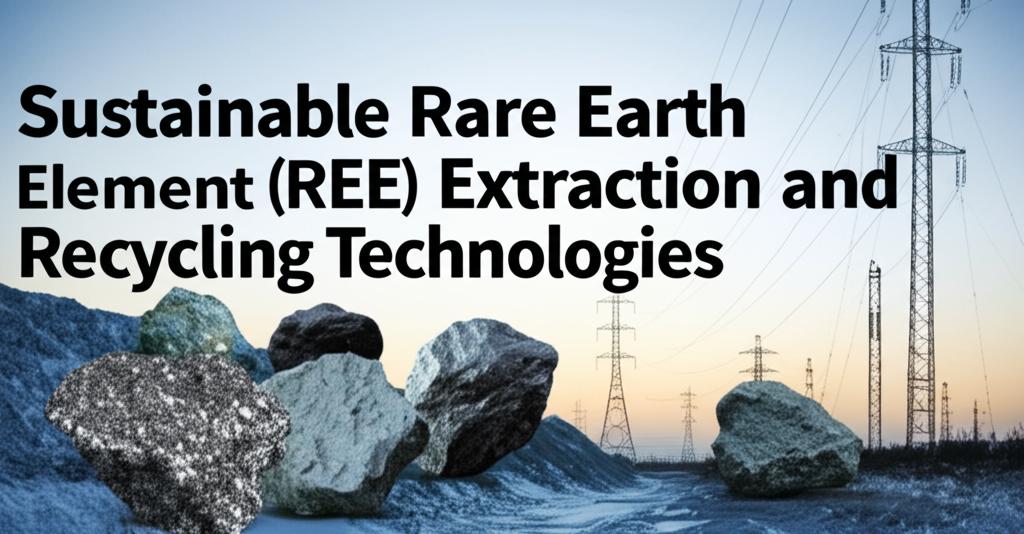Rare Earth Elements (REEs) are indispensable components in numerous modern technologies, powering everything from smartphones and electric vehicle (EV) motors to wind turbines and advanced medical equipment. Despite their name, these 17 elements aren't necessarily rare in the Earth's crust, but their extraction and processing pose significant environmental and geopolitical challenges. Traditional methods often involve energy-intensive processes, harsh chemicals, habitat disruption, and the generation of toxic, sometimes radioactive, waste. Furthermore, the geographic concentration of mining and processing creates supply chain vulnerabilities. Addressing these issues requires a fundamental shift towards sustainable extraction and robust recycling technologies.
Emerging extraction methods aim to minimize the environmental footprint associated with mining. One groundbreaking technique is Electrokinetic Mining (EKM). Developed by researchers, EKM uses an electric current passed through ion-adsorption clay deposits (a major source of heavy REEs) to mobilize and extract the elements. Industrial-scale tests have shown remarkable results, achieving over 95% REE recovery while drastically reducing the need for chemical leaching agents (by up to 80%), mining time (by 70%), and energy consumption (by 60%). Crucially, EKM significantly cuts down on pollution, with monitored tests showing a 95% reduction in ammonia-nitrogen emissions into water sources compared to conventional ammonium-salt leaching methods.
Other innovative and eco-friendlier extraction approaches are also gaining traction. Biomining, or bioleaching, utilizes microbes, such as Gluconobacter bacteria, which naturally produce organic acids capable of leaching REEs from ores or waste materials like spent catalysts. These biological methods are less toxic than traditional chemical leaching, and the resulting waste can biodegrade. Similarly, agromining uses specific plant species known as hyperaccumulators to absorb REEs from soil or waste streams. While land-intensive, this offers a low-cost, environmentally gentle extraction pathway. Inspired by nature, researchers have also developed materials like mussel-inspired nanocellulose coatings (MINC) that can selectively bind to and recover REEs, like neodymium, from industrial wastewater with high efficiency and low energy input.
Equally crucial is the development of efficient REE recycling technologies to create a circular economy, reducing reliance on primary mining. Currently, commercial-scale REE recycling is limited, and valuable elements often end up in landfills. However, several promising technologies are emerging. The Selective Extraction-Evaporation-Electrolysis (SEEE) process, developed in Japan, uses molten salts for selective extraction, followed by evaporation and electrolysis to separate REEs like neodymium and dysprosium with high recovery rates (over 90%) and purity.
Another method adapts continuous chromatography, a technique borrowed from the food industry (used for separating sugars), to separate mixed REEs from liquid solutions using specialized resins. This cross-industry innovation demonstrates a cost-effective path towards recycling. Researchers have also developed processes using copper salts instead of harsh acids to leach REEs from end-of-life magnets found in shredded electronics or manufacturing scrap, achieving high recovery rates (90-98%) with potentially lower environmental impact. Some companies are even implementing direct recycling methods, where old magnets are demagnetized, cleaned, milled into powder, and directly re-processed into new high-performance magnets, bypassing complex chemical separation steps entirely.
Established techniques like hydrometallurgy (using liquid solutions like acids) and pyrometallurgy (using high heat) are also being refined to improve efficiency and reduce environmental harm. Innovations include using novel extractants, minimizing chemical consumption, exploring safer solvents, and employing energy-efficient heating methods like microwave or plasma technology. The concept of "urban mining"—systematically recovering valuable materials from electronic waste, old appliances, and other discarded products—is fundamental to providing secondary sources of REEs.
Ultimately, sustainable REE management requires a holistic approach grounded in the principles of the circular economy. This goes beyond just recycling to encompass strategies like reducing the amount of REE needed in products through smarter design, finding substitute materials where possible, and extending product lifespans through reuse and repair. Implementing these strategies requires collaboration across the entire value chain, from designers and manufacturers to consumers and recyclers. Initiatives are underway to enhance transparency and traceability using technologies like blockchain to certify the sustainability of REE supply chains.
The transition towards sustainable REE extraction and recycling is critical. These innovative technologies and circular economy strategies offer pathways to secure the supply of these vital elements for green energy and high-tech applications, significantly reduce the environmental damage associated with their production, conserve resources, and mitigate geopolitical risks, paving the way for a more sustainable and resilient technological future.

